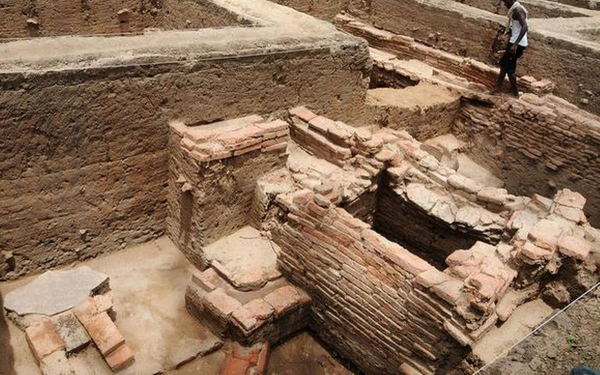கீழடி அகழ்வாராய்ச்சி: முன்பு நினைத்ததை விட பழமையான சங்கம் சகாப்தம், ஆய்வைக் காண்கிறது
சங்கம் வயது பண்டைய சங்க யுகத்தின் கலாச்சார வரலாற்று வரலாற்றில் ஒரு முக்கிய திருப்புமுனையாக, தமிழ்நாட்டின் சிவகங்கா மாவட்டத்தில் கீழடியில் அகழ்வாராய்ச்சியின் போது கண்டுபிடிக்கப்பட்ட கலாச்சார வைப்புகளை கி.மு. 6 ஆம் நூற்றாண்டிற்கும், 1 ஆம் நூற்றாண்டு CE (600 BC-100AD)
சங்கம் வயது பொதுவாக 300BC முதல் 300 AD வரை கருதப்படுகிறது.
ஆனால் சங்க வயது பொருட்கள் கீழடி தளத்திலிருந்து கண்டுபிடிக்கப்பட்டு அமெரிக்காவில் இல் `கார்பன் டேட்டிங்` சோதனைக்கு அனுப்பப்பட்டது கிமு 580 க்கு முந்தையது.
கீழடியில் அகழ்வாராய்ச்சியின் நான்காவது அகழ்விலிருந்து சேகரிக்கப்பட்ட ஆறு கார்பன் மாதிரிகள் முடுக்கி மாஸ் ஸ்பெக்ட்ரோமெட்ரி (ஏஎம்எஸ்) டேட்டிங்கிற்காக பீட்டா அனலிட்டிக் லேப், மியாமி, புளோரிடா, யு.எஸ்.
‘கீழடி-வைகை நதிக்கரையில் சங்கம் யுகத்தின் நகர்ப்புற தீர்வு’ என்ற தலைப்பில் அறிக்கை வெளியிடப்பட்டது
நான்காவது அகழ்வாராய்ச்சியின் முடிவுகள், வைகை சமவெளிகளின் இரண்டாவது நகரமயமாக்கல் [முதலாவது சிந்து] பொ.ச.மு. 6 ஆம் நூற்றாண்டில் தமிழ்நாட்டில் கங்கை சமவெளிகளில் நடந்ததைப் போலவே நிகழ்ந்தது.
முன்னர் பயன்படுத்தியதைப் போல தளத்தின் பெயரை கீழடி எனவும் அறிக்கை சரி செய்கிறது
தமிழ் – பிராமி பழையது – கீழடி கண்டுபிடிப்புகளுக்காக சமீபத்தில் பெறப்பட்ட அறிவியல் தேதிகள் தமிழ்-பிராமி எழுத்துக்களின் தேதியை மற்றொரு நூற்றாண்டுக்கு பின்னுக்குத் தள்ளுகின்றன, அதாவது கிமு 6 ஆம் நூற்றாண்டு.
சங்கம் வயது
இந்த முடிவுகள் பொ.ச.மு 6 ஆம் நூற்றாண்டில் இருந்தே கல்வியறிவும் எழுதும் கலையும் அடைந்தன என்பதை உறுதிப்படுத்தின.
கீழடியில் உள்ள சமூகம் விவசாய நோக்கங்களுக்காக விலங்குகளை முக்கியமாகப் பயன்படுத்தியது என்பதையும் இந்த கண்டுபிடிப்பு தெரிவிக்கிறது.
கீழடியிலிருந்து மட்பாண்ட மாதிரிகள் கனிம பகுப்பாய்விற்காக வேலூர் இன்ஸ்டிடியூட் ஆப் டெக்னாலஜி மூலம் இத்தாலியின் பிசா பல்கலைக்கழகத்தின் பூமி அறிவியல் துறைக்கு அனுப்பப்பட்டதில், உள்நாட்டில் கிடைக்கும் மூலப்பொருட்களிலிருந்து நீர் கொள்கலன்கள் மற்றும் சமையல் பாத்திரங்கள் வடிவமைக்கப்பட்டுள்ளன என்பதை உறுதிப்படுத்தியது.
மூன்று அகழ்வாராய்ச்சிகள் இந்திய தொல்பொருள் ஆய்வுத் துறையால் மேற்கொள்ளப்பட்டாலும், நான்காவது அகழ்வாராய்ச்சியை டி.என்.ஏ.டி மேற்கொண்டது.
டி.என்.ஏ.டி ஐந்தாவது அகழ்வாராய்ச்சி நடந்து வருகிறது.
Keezhadi excavations: Sangam era older than previously thought, finds study
Sangam age In a major turning point in the cultural historiography of the ancient Sangam Age, the Tamil Nadu Archaeology Department (TNAD) has stated that the cultural deposits unearthed during excavations at Keeladi in Sivaganga district in TAMIL Nadu could be traced between 6th century BCE and the 1st century CE (600 BC-100AD)
Sangam age is generally considered between 300BC and 300 AD.
But the Sangam age materials unearthed from Keeladi site and sent for carbon dating test in the U.S. dates back to 580 BCE.
Six carbon samples collected from the fourth season of excavations at Keeladi were sent to Beta Analytic Lab, Miami, Florida, U.S., for Accelerator Mass Spectrometry (AMS) dating.
The report titled, ‘Keeladi-An Urban Settlement of Sangam Age on the Banks of River Vaigai’, was published by the
The results from the fourth excavations suggest that the second urbanization [the first being Indus] of Vaigai plains happened in Tamil Nadu around 6th century BCE as it happened in Gangetic plains.
The report also corrects the site name as Keeladi as against the previously used
Tamil – Brahmi older – The recent scientific dates obtained for Keeladi findings push back the date of Tamil-Brahmi script to another century, i.e., 6th century BCE.
Sangam Age
These results confirmed that literacy and the art of writing had been attained as early as the 6th century BCE.
The finding also suggests that the society in Keeladi had used animals predominantly for agricultural purposes.
Pottery specimens from Keeladi sent to the Earth Science Department of Pisa University, Italy, through Vellore Institute of Technology for mineral analysis, confirmed that water containers and cooking vessels were shaped out of locally available raw materials.
While three excavations were undertaken by the Archaeological Survey of India, the fourth excavation was undertaken by the TNAD.
The fifth excavation by the TNAD is underway.
Accelerator Mass Spectrometry (AMS)
AMS dating involves accelerating the ions to extraordinarily high kinetic energies followed by mass analysis.
Although more expensive than radiometric dating, AMS dating has higher precision and needs small sample sizes.
There are two techniques in measuring radiocarbon in samples
Radiometric dating
Accelerator Mass Spectrometry (AMS).
The two techniques are used primarily in determining carbon 14 content of archaeological artifacts and geological samples.
Difference between both processes?

Difference between both processes?
Radiometric dating methods detect beta particles from the decay of carbon 14 atoms
On the other hand, accelerator mass spectrometers count the number of carbon 14 atoms present in the sample.
Advantages of AMS:
The greatest advantage that AMS radiocarbon dating has over radiometric methods is small sample size.
Radiocarbon dating is a destructive process. Hence, because of its ability to analyze samples even in minute amounts, accelerator mass spectrometry is the method of choice for archaeologists with small artifacts and those who cannot destroy very expensive or rare materials.
Due to the sensitivity of accelerator mass spectrometers, carbon dating small particles like blood particles, a grain, or a seed has been made possible.
Accelerator mass spectrometry also takes less time to analyze samples for carbon 14 content compared to radiometric dating methods that can take one or two days. An accelerator mass spectrometer has a run time of a few hours per sample.
Lastly, it must be noted that AMS measurements usually achieve higher precision and lower backgrounds than radiometric dating methods.
Source 1
